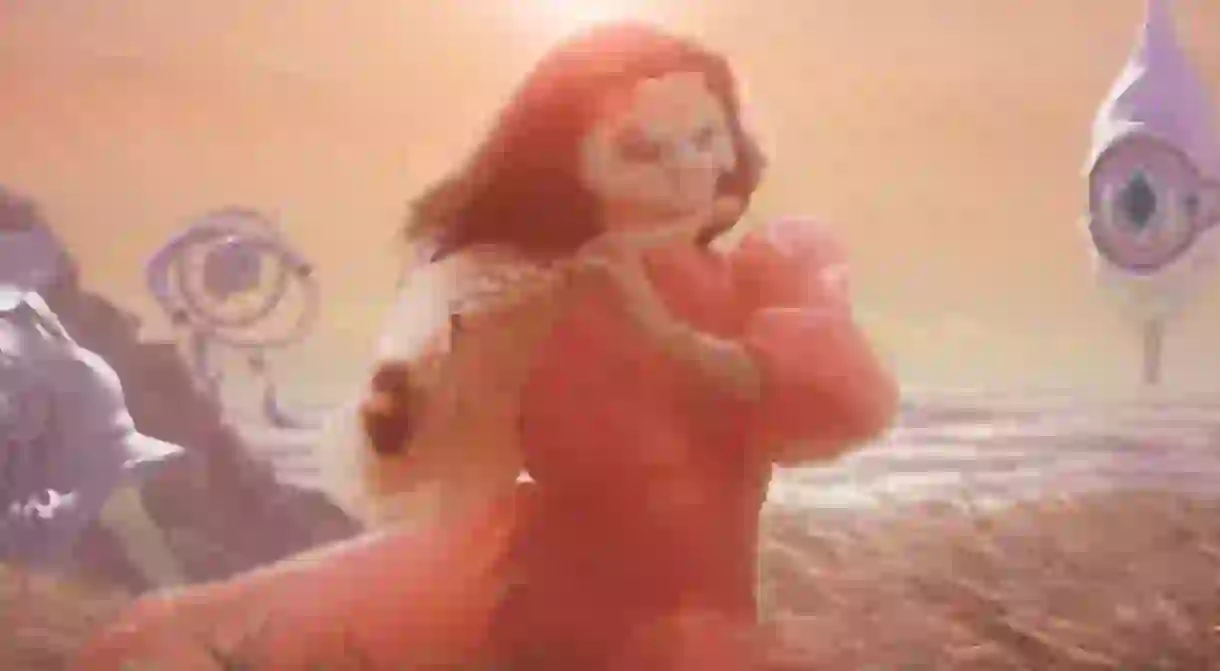The Evolution of Björk in Ten Songs

With the release of Björk’s latest album, Utopia, her musical prowess is seemingly never-ending, charting her life and personal growth through lyrics both intimate and universal. While Björk is now a name everyone knows, her humble beginnings in Iceland were precocious from the start, as her unique singing voice and stage presence was recognised right away. Utopia may represent Björk as she is today, but it comes after nine solo albums, making it even more impactful when put into context with her previous output that spans over four decades. The following songs represent the evolution of the singer.
‘I Love to Love’ (1977)
Björk, born in 1965, began her career at the tender age of 11, when she made her first public appearance on an Icelandic radio station singing ‘I Love to Love.’ Through the song she landed a record deal, which saw the release of her first record, Björk, a year later.

‘Mataharí’ with Tappi Tíkarrass (1982)
During her teenage years, Björk sang in a variety of experimental punk bands, including Tappi Tíkarrass (which translates to ‘put a cork in the bitch’s arse’), active between 1981 and 1983, and Kukl (‘Sorcery’) active between 1983 and 1986. With these bands, we can hear Björk’s signature experimental vocal range explored to the max. A documentation of these early days can be seen in the music documentary Rökk í Reykjavík, which features other exciting punk bands from this vibrant period in Icelandic music history.

‘Birthday’ with The Sugarcubes (1987)
The Sugarcubes was the most popular band Björk was a member of at the time. Active between 1986 and 1992, The Sugarcubes’ signature hit was ‘Birthday.’ Their sound was described as avant-pop and psychedelic post-punk, with Björk’s feminine voice interspersed with her bandmate’s erratic vocals. Her time with The Sugarcubes presented further experimentation with her signature vocal style, which would develop in her break-out solo albums after The Sugarcubes disbanded.

‘Human Behavior’ – Debut (1993)
Debut was Björk’s first international solo studio album, featuring songs she had written while she was still a teenager. The album represents the emergence of her solo musical identity and saw the incorporation of house beats, which she had been introduced to in the club scene in London during the early 1990s. Her next solo albums, Post (1995) and Homogenic (1997), also involve a collaborative effort of musicians active in house music, trip-hop, and electronica.

‘Hidden Place’ – Vespertine (2001)
The album Vespertine, which features the single ‘Hidden Place’, utilises more ambient and glitch beats than her previous works. Intended by the singer to be more intimate and domestic, it also introduces the singer’s first involvement with experimental instrumentation, combining electronica with instruments such as the clavichord, harp, and music boxes. The lyrics also became more intimate than before.

‘Mouth’s Cradle’ – Medúlla (2004)
Medúlla was an extremely experimental album, consisting almost completely of human vocals sung a capella, in addition to a few musical instruments such as synthesizer, piano, and gong. Many songs in the album, including ‘Mouth’s Cradle’, make use of a cut-up method of vocals. Here, we witness Björk continue her ever-experimental exploration of avant-garde pop with even more brevity and development of her own unique vision. As usual, the visuals are stunning.

‘Innocence’ – Volta (2007)
The album Volta represents a noticeable return to the more pop sound of her previous albums, although the singer has stated that the album was intended to be more of an experiment to see where pop music and her previously avant-garde work overlap. The result is a collective effort featuring a variety of musicians including Toumani Diabaté, the legendary Malian kora player, and electronic musician Mark Bell.

‘Moon’ – Biophilia (2011)
Developed as a concept album during the 2008–2011 Icelandic financial crisis, the album explores the interlinking ideas between nature, music, and technology. Fittingly, the album was the first app album released alongside a series of apps about musicology. The album features new musical instruments, including a Tesla coil, a gameleste, and gravity harps. The song ‘Moon’ includes different musical cycles repeating throughout the song with lyrics that make metaphors between natural phenomena and their effects on human beings. The mesmerising songs introduce us to the increasing innovation of the singer’s concepts and, in some ways, accumulates all of the progress made in her previous albums.

‘Stonemilker’ – Vulnicura (2015)
Vulnicura is the singer’s breakup album, in which the lyrics and ambiance relate to the painful experience. The lyrics represent a return to intimate subject matter, while the songs incorporate electronic and ambient elements. The album’s release coincided with the release of Björk Digital, an 18-month, world-traveling virtual reality experience showcasing the singer’s continuing evolution with music and technology, as well as her emotionally honest expression.

‘The Gate’ – Utopia (2017)
The first single on her latest album, Utopia, ‘The Gate’ pushes beyond the personal pain of Vulnicura and explores ideas of transcendent love. The full album, which will be released on November 24, 2017, is instigated by the current political climate and uncertainty, and the need to visualise a utopia. In her latest album, the singer shows us her musical mastery and personal evolution, as she pairs her electronica background with a poetic flute ensemble in a stunning music video clip.














